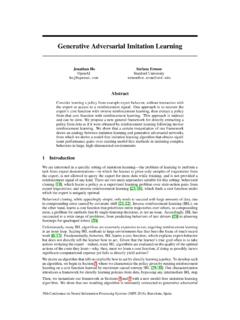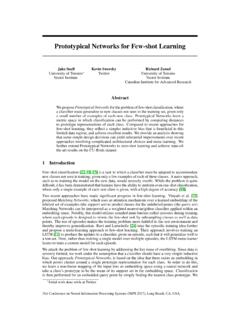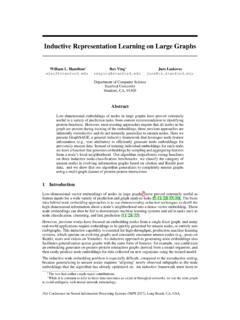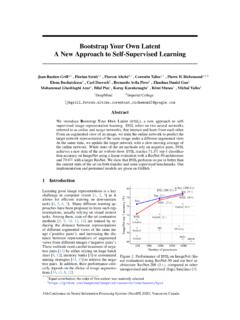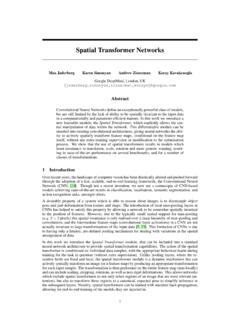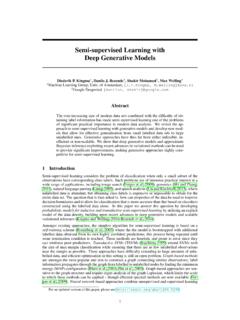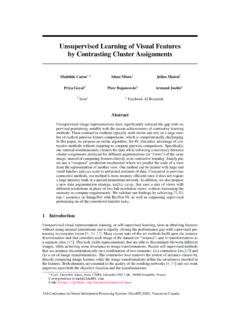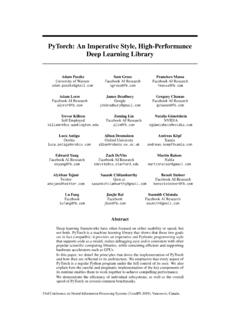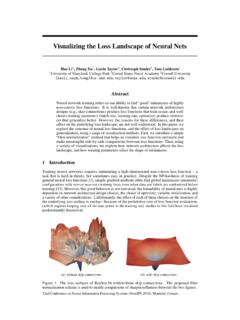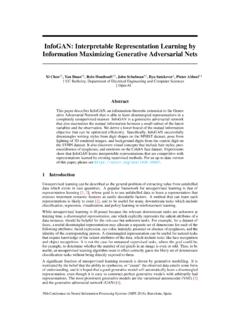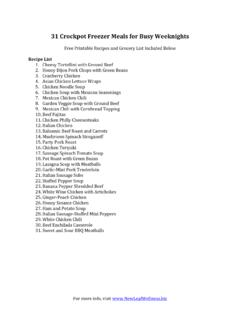Transcription of Policy Gradient Methods for Reinforcement Learning with ...
1 Policy Gradient Methods for Reinforcement Learning with Function Approximation Richard S. Sutton, David McAllester, Satinder Singh, Yishay Mansour AT&T Labs - Research, 180 Park Avenue, Florham Park, NJ 07932 Abstract Function approximation is essential to Reinforcement Learning , but the standard approach of approximating a value function and deter-mining a Policy from it has so far proven theoretically intractable. In this paper we explore an alternative approach in which the Policy is explicitly represented by its own function approximator, indepen-dent of the value function, and is updated according to the Gradient of expected reward with respect to the Policy parameters.
2 Williams's REINFORCE method and actor-critic Methods are examples of this approach. Our main new result is to show that the Gradient can be written in a form suitable for estimation from experience aided by an approximate action-value or advantage function. Using this result, we prove for the first time that a version of Policy iteration with arbitrary differentiable function approximation is convergent to a locally optimal Policy . Large applications of Reinforcement Learning (RL) require the use of generalizing func-tion approximators such neural networks, decision-trees, or instance-based Methods .
3 The dominant approach for the last decade has been the value-function approach, in which all function approximation effort goes into estimating a value function, with the action-selection Policy represented implicitly as the "greedy" Policy with respect to the estimated values ( , as the Policy that selects in each state the action with highest estimated value). The value-function approach has worked well in many appli-cations, but has several limitations. First, it is oriented toward finding deterministic policies, whereas the optimal Policy is often stochastic, selecting different actions with specific probabilities ( , see Singh, Jaakkola, and Jordan, 1994).
4 Second, an arbi-trarily small change in the estimated value of an action can cause it to be, or not be, selected. Such discontinuous changes have been identified as a key obstacle to estab-lishing convergence assurances for algorithms following the value-function approach (Bertsekas and Tsitsiklis, 1996). For example, Q-Iearning, Sarsa, and dynamic pro-gramming Methods have all been shown unable to converge to any Policy for simple MDPs and simple function approximators (Gordon, 1995, 1996; Baird, 1995; Tsit-siklis and van Roy, 1996; Bertsekas and Tsitsiklis, 1996). This can occur even if the best approximation is found at each step before changing the Policy , and whether the notion of "best" is in the mean-squared-error sense or the slightly different senses of residual- Gradient , temporal-difference, and dynamic-programming Methods .
5 In this paper we explore an alternative approach to function approximation in RL. 1058 R. S. Sutton, D. McAl/ester. S. Singh and Y. Mansour Rather than approximating a value function and using that to compute a determinis-tic Policy , we approximate a stochastic Policy directly using an independent function approximator with its own parameters. For example, the Policy might be represented by a neural network whose input is a representation of the state, whose output is action selection probabilities, and whose weights are the Policy parameters. Let 0 denote the vector of Policy parameters and p the performance of the corresponding Policy ( , the average reward per step).
6 Then, in the Policy Gradient approach, the Policy parameters are updated approximately proportional to the Gradient : ap ~O~CtaO' (1) where Ct is a positive-definite step size. If the above can be achieved, then 0 can usually be assured to converge to a locally optimal Policy in the performance measure p. Unlike the value-function approach, here small changes in 0 can cause only small changes in the Policy and in the state-visitation distribution. In this paper we prove that an unbiased estimate of the Gradient (1) can be obtained from experience using an approximate value function satisfying certain properties.
7 Williams's (1988, 1992) REINFORCE algorithm also finds an unbiased estimate of the Gradient , but without the assistance of a learned value function. REINFORCE learns much more slowly than RL Methods using value functions and has received relatively little attention. Learning a value function and using it to reduce the variance of the Gradient estimate appears to be ess~ntial for rapid Learning . Jaakkola, Singh and Jordan (1995) proved a result very similar to ours for the special case of function approximation corresponding to tabular POMDPs. Our result strengthens theirs and generalizes it to arbitrary differentiable function approximators.
8 Konda and Tsitsiklis (in prep.) independently developed a very simialr result to ours. See also Baxter and Bartlett (in prep.) and Marbach and Tsitsiklis (1998). Our result also suggests a way of proving the convergence of a wide variety of algo-rithms based on "actor-critic" or Policy -iteration architectures ( , Barto, Sutton, and Anderson, 1983; Sutton, 1984; Kimura and Kobayashi, 1998). In this paper we take the first step in this direction by proving for the first time that a version of Policy iteration with general differentiable function approximation is convergent to a locally optimal Policy .
9 Baird and Moore (1999) obtained a weaker but superfi-cially similar result for their VAPS family of Methods . Like Policy - Gradient Methods , VAPS includes separately parameterized Policy and value functions updated by gra-dient Methods . However, VAPS Methods do not climb the Gradient of performance (expected long-term reward), but of a measure combining performance and value-function accuracy. As a result, VAPS does not converge to a locally optimal Policy , except in the case that no weight is put upon value-function accuracy, in which case VAPS degenerates to REINFORCE. Similarly, Gordon's (1995) fitted value iteration is also convergent and value-based, but does not find a locally optimal Policy .
10 1 Policy Gradient Theorem We consider the standard Reinforcement Learning framework (see, , Sutton and Barto, 1998), in which a Learning agent interacts with a Markov decision process (MDP). The state, action, and reward at each time t E {O, 1, 2, .. } are denoted St E S, at E A, and rt E R respectively. The environment's dynamics are characterized by state transition probabilities, P:SI = Pr { St+ 1 = Sf I St = s, at = a}, and expected re-wards 'R~ = E {rt+l 1st = s, at = a}, 'r/s, Sf E S, a E A. The agent's decision making procedure at each time is characterized by a Policy , 1l'(s, a, 0) = Pr {at = alst = s, O}, 'r/s E S,a E A, where 0 E ~, for l lSI, is a parameter vector.
